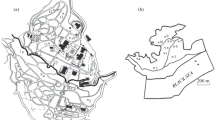Abstract
A landscape and ecological analysis is made of the structure of soil zoocenoses in the Tunka depression and the foothill area of Khamar–Daban. We examine the patterns of change in quantitative characteristics and taxonomic diversity of invertebrate communities in the landscape–ecological range under the influence of natural and anthropogenic factors. Taxonomic diversity and structure change mainly in the gradient of edapho–climatic and phytocenotic conditions which vary with the location of a biogeocenosis in the landscape. Within the taiga and forest landscapes, the general regularity of distribution of soil invertebrates is an increase in the number of species from steppificated pine and larch forests to dark coniferous–fir and mixed sufficiently moist biogeocenoses of the mountain forest belt. The relatively low heat availability of the root layer, combined with high humidity, and also the high temperatures that lead to drying of the soil, negatively affect on the taxonomic diversity of the mesopopulation. The main trend of change in taxonomic diversity of pedobiont communities is a decrease of the number of species in the gradient of increasing climate aridity, and an enhancement in hypothermaia and anthropogenic pressure. A structural and dynamical analysis identified two main types of structure of the communities: mesothermohygrophile (with a relatively small contribution from of insects and a large contribution from annelids), and xeroresistant (with a significant involvement of representatives of the insecta class. The first type includes zoocomplexes of taiga, forest, meadow and wetland biogeocenoses represented mainly by moisture–loving forms; the second type includes steppificated, steppe and radically anthropogenically disturbed biogeocenoses, the composition of which is dominated by invertebrates with relatively short development cycles and largely adapted to moisture deficit.
Similar content being viewed by others
References
Sochava, V.B. An Introduction to the Theory of Geosystems, Novosibirsk: Nauka, 1978 [in Russian].
Tishkov, A.A. Biospheric Functions of Natural Ecosystems of Russia, Moscow: Nauka, 2005 [in Russian].
Tilman, D.D. The Ecological Consequences of Change in Biodiversity: A Search for General Principles, Ecology, 1999, vol. 80, issue 5, pp. 1455–1474.
Pokarzhevskii, A.D. Gongal’skii, K.B. Zaitsev, A.S. and Savin, F.A. Spatial Ecology of Soil Animals, Moscow: KMK, 2007 [in Russian].
Bessolitsyna, E.P. Landscape–Ecological Analysis of the Structure of Soil Geocenoses in the South of Siberia, Irkutsk: Inst. Geogr. SO RAN, 2001 [in Russian].
Ganin, G.N. Structural–Functional Organization of Mesopedobiont Communities in the South of the Far East of Russia, Vladivostok: Dal’nauka, 2011 [in Russian].
Chesnova, L.V. and Striganova, B.R. Soil Ecology–Science of the 20th Century, Moscow: Yanus–K, 1999 [in Russian].
Sochava, V.B. Geography and Ecology (Ser.: Material for the V Congress of the Russian Geographical Society), Leningrad; [Irkutsk: Tipografiya No. 1], 1970 [in Russian].
Krauklis, A.A. Problems in Experimental Landscape Science, Novosibirsk: Nauka, 1979 [in Russian].
Gilyarov, M.S. Characteristics of the Soil as the Habitat and Its Significance in the Evolution of Insects, Moscow; Leningrad: AN SSSR, 1949 [in Russian].
Gilyarov, M.S. The Zoological Method of Soil Diagnostics, Moscow: Nauka, 1965 [in Russian].
Wallwork, J.A. Ecology of Soil Animals, London: McGraw–Hill, 1970.
Wallwork, J.A. The Distribution and Diversity of Soil Fauna, London; New York; San Francisco: Academic Press, 1976.
Mordkovich, V.G. Zoological Diagnostics of Soils in the Forest–Steppe and Steppe Zones of Siberia, Novosibirsk: Nauka, 1977 [in Russian].
Sochava, V.B. Mikheev, V.S. and Ryashin, V.A. General Landscape Map** on the Basis of Integration of Elementary Geosystems, Dokl. Inst. Geogr. Sibiri i Dal’nego Vostoka, 1965, issue 10, pp. 9–22 [in Russian].
Kholboeva, S.A. and Namzalov, B.B. Steppes of the Tunka Depression (Southwestern Cisbaikalia), Ulan–Ude: Buryat. Univ., 2000 [in Russian].
The Program and Technique of Biogeocenological Investigations, N.V. Dylis, Ed., Moscow: Nauka, 1987 [in Russian].
Quantitative Methods in Soil Zoology, M.S. Gilyarov and B.R. Striganova, Eds., Moscow: Nauka, 1987 [in Russian].
Bessolitsyna, E.P. Spatial Analysis of Changes in the Coenosis Diversity of Soil Biota in Taiga Geosystems, Geogr. Prir. Resur., 2005., no. 2, pp. 123–131 [in Russian].
Bessolitsyna, E.P. Soil Mesopopulation Distribution Patterns in Geosystems of the Southern Part of East Siberia, Problemy Regionl’noi Ekologii, 2013, no. 1, pp. 22–27 [in Russian].
Levy, R.A. and Nufio, C.R. Dispersal Potential Impacts Size Clines of Grasshoppers Across an Elevation Gradient, Oikos, 2015, vol. 124, issue 5, pp. 610–619.
Bessolitsyna, E.P. Landscape–Ecological Analysis of the Organization of Soil–Biotic Communities in Geosystems of the South of Siberia, Saarbrücken: Lambert Academic Publishing, 2016 [in Russian].
Author information
Authors and Affiliations
Corresponding author
Additional information
Original Russian Text © E.P. Bessolitsyna, I.V. Balyazin, N.N. Voropai, 2018, published in Geografiya i Prirodnye Resursy, 2018, Vol. 39, No. 4, pp. 130–138.
Rights and permissions
About this article
Cite this article
Bessolitsyna, E.P., Balyazin, I.V. & Voropai, N.N. Structure and Diversity of Soil Zoocenoses in the Tunka Depression. Geogr. Nat. Resour. 39, 358–364 (2018). https://doi.org/10.1134/S1875372818040091
Received:
Published:
Issue Date:
DOI: https://doi.org/10.1134/S1875372818040091




